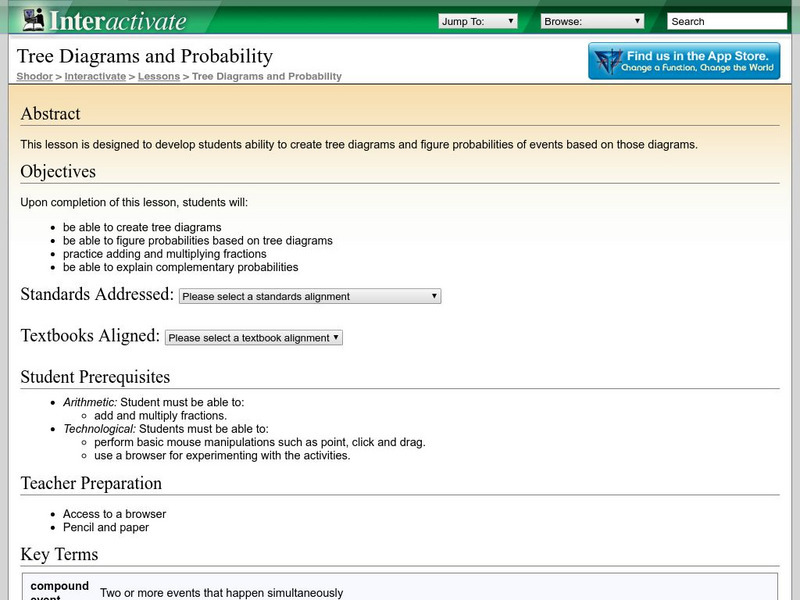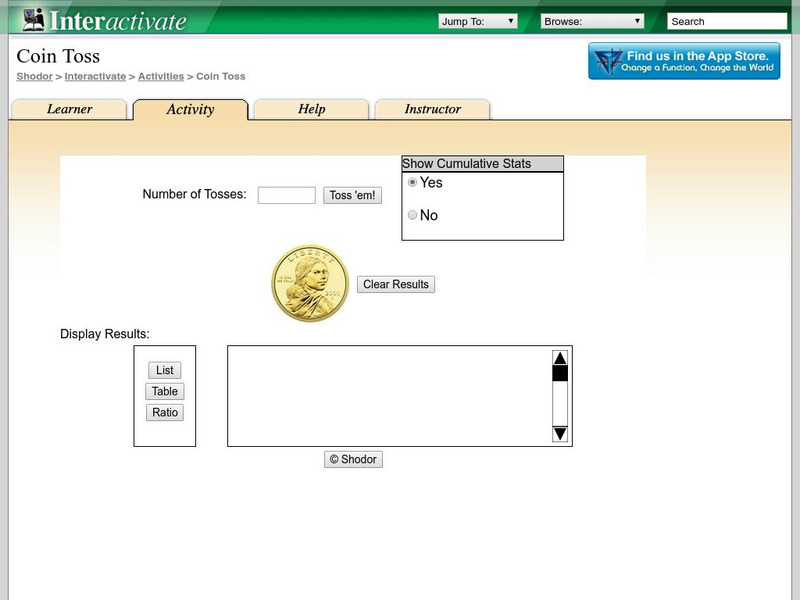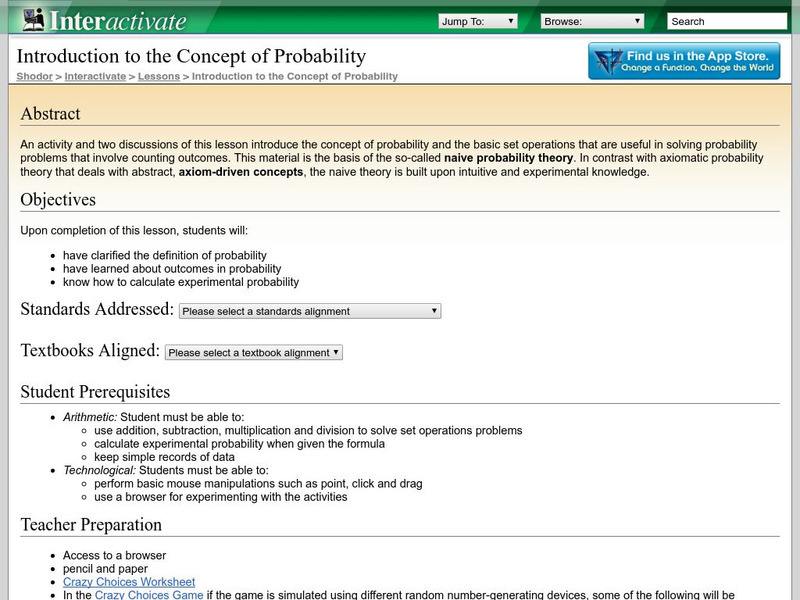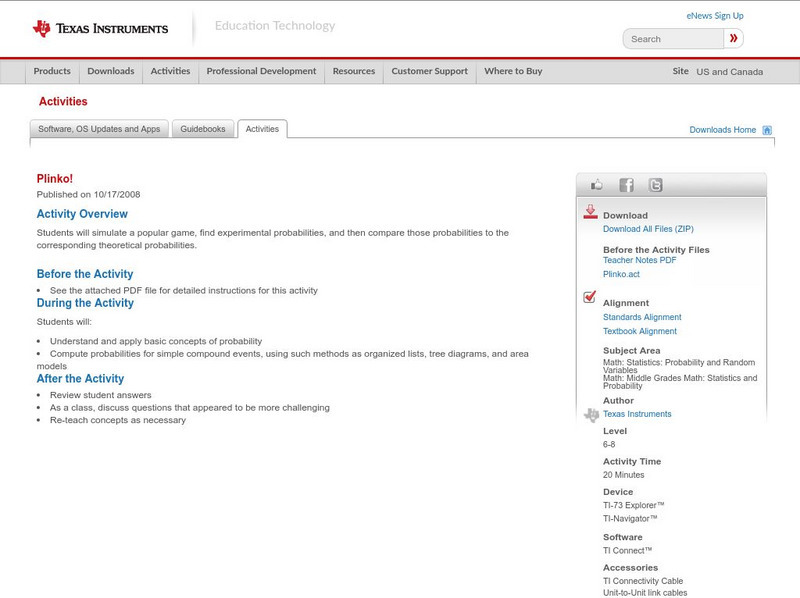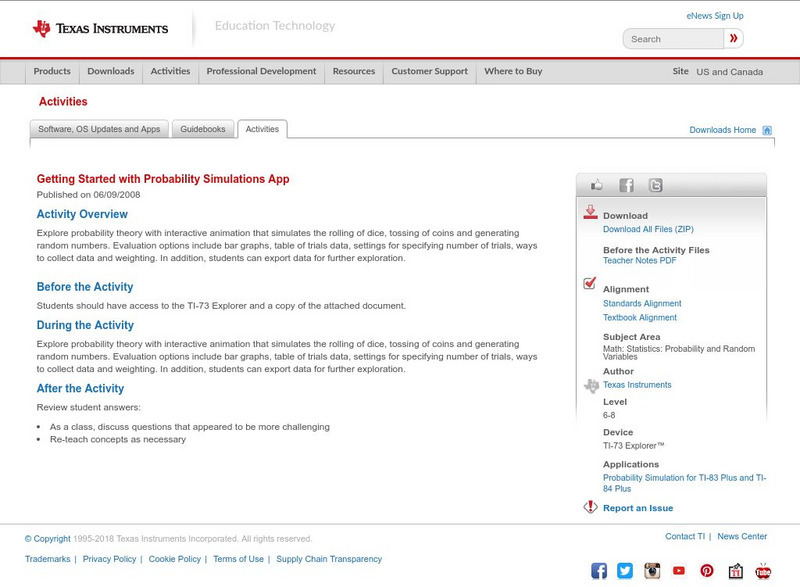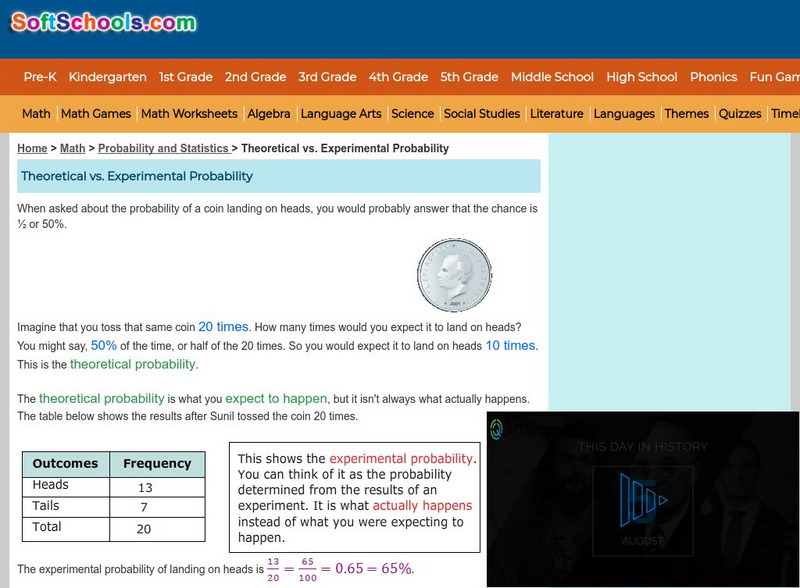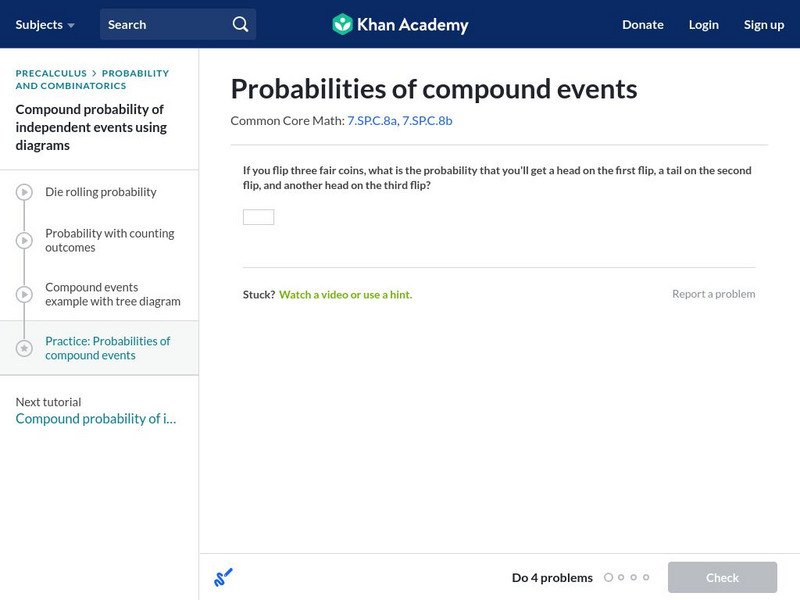McGraw Hill
Glencoe: Self Check Quizzes the Language of Chance
Questions are randomly created to quiz learners on the language of chance. Hints and solutions are included.
CK-12 Foundation
Ck 12: Probabilities of Compound Events
[Free Registration/Login may be required to access all resource tools.] A detailed explanation of how to use tree diagrams and tables to find the probability of compound events. Also looks at dependent events. Includes example problems...
OER Commons
Oer Commons: Experimental Probability
Learners will extend their understanding of probability by continuing to conduct experiments, this time with four-colored spinners. They will compare experimental results to expected results by first conducting an experiment, then...
OER Commons
Oer Commons: Compound Events & Sample Spaces
Seventh graders begin learning about compound events by considering independent events. They will consider everyday objects with known probabilities. Students will represent sample spaces using lists, tables, and tree diagrams in order...
Cuemath
Cuemath: Frequency Distribution Table
A comprehensive guide for learning all about frequency distribution tables with definitions, how to create a frequency distribution table, and the formulas and graphs related to frequency distributions. With solved examples and...
University of Regina (Canada)
University of Regina: Math Central: Probability and Statistics K 6
A compilation of resources devoted to teaching probability and statistics. The resources are broken into seventeen different objectives that have a problem, activity, and a game.
Shodor Education Foundation
Shodor Interactivate: Lesson: Tree Diagrams and Probability
This lesson plan helps young scholars develop tree diagrams and figure probability of events based on diagrams. Lots of resources are available to support teachers and students at this website.
Shodor Education Foundation
Shodor Interactivate: Coin Toss
A simple coin-toss simulation through which young scholars explore experimental probability. Accompanied by links to related activities, discussions, worksheets, and materials for instructors.
Shodor Education Foundation
Shodor Interactivate: Lesson: Intro to the Concept of Probability
The Shodor Education Foundation provides this lesson plan to introduce students to the concepts of probability. Students learn about the definition of, outcomes in, and calculations of experimental probability. Students use an...
Shodor Education Foundation
Shodor Interactivate: Marbles
Students learn about sampling with and without replacement by simulating marbles being drawn out of a bag. Settings can be altered to explore conditional probability.
Texas Instruments
Texas Instruments: Plinko!
In this activity, students will simulate a popular game, find experimental probabilities, and then compare those probabilities to the corresponding theoretical probabilities.
Texas Instruments
Texas Instruments: Getting Started With Probability Simulations App
Explore probability theory with interactive animation that simulates the rolling of dice, tossing of coins and generating random numbers. Evaluation options include bar graphs, table of trials data, settings for specifying the number of...
Texas Instruments
Texas Instruments: Will Girls and Boys Be Equal?
Students explore concepts in probability and statistics. In this activity, they model a situation to find experimental probability and construct a box-and-whisker plot. They compare the experimental and theoretical probabilities for the...
Texas Instruments
Texas Instruments: Heads Up!
In this activity, students study some important concepts of probability. They use coin tossing experiments to determine the probability of a tossed coin coming up heads. They examine both short and long term experimental probabilities...
McGraw Hill
Glencoe Mathematics: Online Study Tools: Probability of Simple Events
This site gives a short interactive quiz which allows students to self-assess their understanding of the concept of the probability of simple events.
University of Cambridge
University of Cambridge: Maths and Sports: Archery
Use our interactivity to simulate picking up a bow and some arrows and trying to hit the target a few times. Can you work out the best settings for the sight? This activity gives an opportunity to gather and collate data, and to test...
Mangahigh
Mangahigh: Data: Probability Scale
Students explore the concept of probability scale by working through an online tutorial and then attempting a ten question quiz that increases in difficulty as questions are answered correctly.
Mangahigh
Mangahigh: Data: Listing All Possible Outcomes
Students learn about the concept of possible outcomes by exploring a tutorial. They can then test their knowledge by taking a ten question assessment that increases in difficulty as they correctly answer questions.
Khan Academy
Khan Academy: Probabilities of Compound Events
In this exercise, students practice finding the probabilities of compound events. Students receive immediate feedback and have the opportunity to get hints and try questions repeatedly.
Khan Academy
Khan Academy: Experimental Probability
Practice making reasonable estimates of the likelihood of future events based on past experience. Students receive immediate feedback and have the opportunity to try questions repeatedly, watch a video or receive hints.
Khan Academy
Khan Academy: Sample Spaces for Compound Events
In this exercise, students practice identify whether sample spaces fit compound events. Students receive immediate feedback and have the opportunity to get hints and try questions repeatedly.
Soft Schools
Soft Schools: Theoretical vs. Experimental Probability
Explains, using examples, the difference between theoretical and experimental probability.
Texas Education Agency
Texas Gateway:using Theoretical and Experimental Probability to Make Predictions
Given an event to simulate, the student will use theoretical probabilities and experimental results to make predictions and decisions.
Khan Academy
Khan Academy: Probabilities of Compound Events
Practice using sample space diagrams to find probabilities. Students receive immediate feedback and have the opportunity to try questions repeatedly, watch a video or receive hints.






